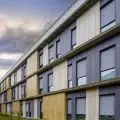Aleksandra Rękas and Monika Sęk from the Faculty of Architecture at the West Pomeranian University of Technology in Szczecin focused on the issue of biophilia in architecture in the context of external and internal connections with nature and regional architecture of West Pomeranian areas. They created a project to develop the area of a fragment of the Międzyodrze River intended for a complex of footbridges and
bridges, a building in Gryfino with an educational function on the flora found in the Lower Oder Valley area, and a building in Mescherin related to the fauna of the same region.
projection of the project area
© Aleksandra Rękas and Monika Sęk
project area
The project area was chosen due to its close proximity to the Lower Oder Valley Landscape Park and is expected to contribute to the activation of the area. The potential of the riverside areas of Gryfino and Mescherin, which are an important element in the further development of these cities, was used. The project includes two buildings located on the Polish-German border, in the West Pomeranian Voivodeship. One of the buildings has been located in Gryfino, while the second facility has been planned on the German side, in Mescherin. The two facilities will be connected by footbridges
located in the area of Miedzyodrze, between the Western Oder and the Eastern Oder (Regalica).
layout plan of the footbridges
© Aleksandra Rękas and Monika Sęk
flora center in Gryfino
The designed building is about raising awareness, educating residents and visitors about the flora of the Lower Oder Valley. Thanks to carefully selected design solutions, the facility allows direct contact with nature, which allows to expand knowledge of local flora.
footbridge cross sections
© Aleksandra Rękas and Monika Sęk
The building consists of 3 aboveground and 2 underground floors, using a reinforced concrete structure, providing spaciousness to the interiors and allowing the introduction of vegetation inside the building. Its form is based on a rectangular plan with gabled glass roofs, harmonizing with the downtown environment. The building's facades are equipped with anti-reflective glass and louvers to control the intensity of incoming light. The structure is based on reinforced concrete columns surrounded by a glass envelope, which gives the building lightness and integrates its interior with the surrounding environment through the visibility of greenery. The corners of the building, where the staircases are located, emphasize the symmetry of the mass and provide a clear circulation system on all levels. A passageway connecting the building to the boulevard was built into the western elevation, facing the Oder River, creating an entrance to the inner space. A staircase is planned on the central axis of the entrance, which serves as public seating. The design also provides for ramps located outside the main outline of the building, which facilitates movement between levels and allows for free sightseeing.
block formation scheme and development plan
© Aleksandra Rękas and Monika Sęk
The functional layout of the building is based on maintaining a clear communication system on all levels to facilitate sightseeing. The object has 5 floors, two of them are underground floors and three above-ground floors. The underground floors are used to service the building and the surface of the above-ground levels as recreational and educational space. The building is equipped with 5 escape staircases, 4 of which are located in the corners of the building and one is located in the central part in the underground garage.
visualization
© Aleksandra Rękas and Monika Sęk
Level -2 includes warehouses, technical rooms and a parking lot for 100 stalls, including for the disabled. Level -1 additionally includes warehouses, a fan room, a transformer station and audiovisual and multimedia rooms. Levels 0 and 1 contain administrative and social rooms, a restaurant and a store. The vegetation is divided into zones corresponding to the different environments of the Lower Oder Valley. A space for workshops on plant cultivation and a viewing balcony with a year-round glass canopy, offering views of the Oder River and Międzyodrze River, are planned for Level 2.
visualization
© Aleksandra Rękas and Monika Sęk
Mescherin fauna center
The designed building is related to education about the fauna of the Lower Oder Valley. The building consists of 1 overground storey and 1 underground storey, and its construction combines wood with reinforced concrete reinforcement, which provides spacious interiors.
cross-section A-A
© Aleksandra Rękas and Monika Sęk
The building's facades are decorated with half-timbered elements referring to the regional architecture of Western Pomerania. The building, with a quadrilateral plan, is topped with gabled roofs. The centerpiece of the building is the main hall with a glass roof, which serves as the main entrance. The façade features adjustable wooden louvers to control the indoor climate, especially in areas exposed to excessive sunlight. The roof peaks on the eastern elevation are made of wooden elements, separated by glass panels. Additional glazing in the roof over the main exhibition halls provides an additional source of natural light.
B-B section
© Aleksandra Rękas and Monika Sęk
The functional layout of the facility is based on maintaining a clear communication system on all levels to facilitate visiting. The building has 1 evacuation staircase and 1 representative staircase. On level -1 of the building there are exhibition spaces, technical and utility rooms, multimedia rooms and the main hall. This floor concentrates exhibitions on aquatic animals and aquariums presenting species from the Lower Oder Valley. Exceptionally, the bird sound recognition room has been placed on this level due to the requirement for shading. The administrative area, checkroom, visitor toilets, research rooms, laboratory, offices, social rooms and a restaurant with facilities were located on level 1. The themes of the exhibitions have been divided into zones according to the environments represented: aquatic fauna on level -1 and terrestrial fauna on level 1.
elevation view, axonometry
© Aleksandra Rękas and Monika Sęk
footbridge and bridge complex
The project of footbridges and bridges, designed along the banks of the Gryfino Canal and the Broad Canal, aims to allow visitors to enjoy the picturesque views of the Lower Oder Valley Landscape Park and direct contact with nature. The solution will increase visitors' knowledge of the flora and fauna of the Międzyodrze River by providing 6 platforms with information boards about protected species and Natura 2000 areas. The project includes footbridges without barriers, promoting closer contact with nature, and their elevation above ground level minimizes the impact on the environment and does not disturb the natural development of the area.
elevations
© Aleksandra Rękas and Monika Sęk
The premise contributes to the activation of previously undeveloped areas. The design concept gives meaning and is intended to arouse interest among users and users about the previously underexplored area of the Lower Oder Valley.
A fragment of the C-C section, a diagram of the structure's construction
© Aleksandra Rękas and Monika Sęk








































































